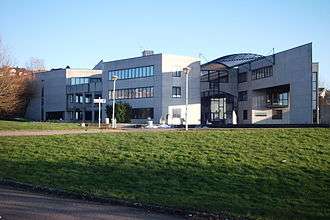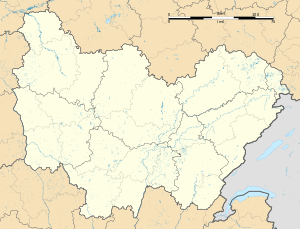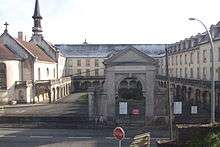Vesoul
Vesoul (French pronunciation: [vəzul] (![]()
Vesoul | |
|---|---|
Prefecture and commune | |
    | |
 Coat of arms | |
Location of Vesoul 
| |
 Vesoul  Vesoul | |
| Coordinates: 47°37′23″N 6°09′21″E | |
| Country | France |
| Region | Bourgogne-Franche-Comté |
| Department | Haute-Saône |
| Arrondissement | Vesoul |
| Canton | Vesoul-1 and 2 |
| Intercommunality | CA Vesoul |
| Government | |
| • Mayor (2012-2014) | Alain Chrétien |
| Area 1 | 9.07 km2 (3.50 sq mi) |
| Population (2017-01-01)[1] | 14,916 |
| • Density | 1,600/km2 (4,300/sq mi) |
| Time zone | UTC+01:00 (CET) |
| • Summer (DST) | UTC+02:00 (CEST) |
| INSEE/Postal code | 70550 /70000 |
| Elevation | 213–375 m (699–1,230 ft) (avg. 220 m or 720 ft) |
| 1 French Land Register data, which excludes lakes, ponds, glaciers > 1 km2 (0.386 sq mi or 247 acres) and river estuaries. | |
It is the most populated municipality of the department with 15,212 inhabitants in 2014. The same year, the Communauté d'agglomération de Vesoul which covers 20 municipalities together had 34,310 inhabitants while the Urban area of Vesoul which includes 78 municipalities, had 59,244 inhabitants. Its inhabitants are known in French as Vésuliens.
Built on top of the hill of La Motte in the first millennium under the name of Castrum Vesulium, the city gradually evolved into a European commercial and economic center. At the end of the Middle Ages, the city experienced a challenging period beset with plagues, epidemics, and localized conflict.
Main urban center of the department, Vesoul is also home to a major PSA parts manufacturing plant and to the Vesoul International Film Festival of Asian Cinema. It was immortalized by Jacques Brel in his 1968 song "Vesoul".
The town is the capital of the department of Haute-Saône.
History
Vesoul is first mentioned in a document dated 899. That document speaks about an elevation with a fortified watchtower. The document speaks about "Castrum Vesulium". Castrum is a fortification, and "Vesulium" has the syllable ves which meant hill or mountain in a language that was spoken before the Celts. Today, there is a castle that forms the centre of the city. The first houses were built inside the walls of the castle. Newcomers who found no place settled outside the city walls, on the flanks of the hill. Growing wine was popular. In 1814, after the fall of the empire, a buffer state was created, with Vesoul as capital. The principality was that of Free County, of the Vosges and of Porrentruy.
Today, one of the main factories of PSA Peugeot Citroën is near Vesoul.
Geography

Vesoul is located in the center of the Haute-Saône and is equidistant from the other cities of the department. It is located at the intersection of highways 19 and 57, on the SNCF Paris-Basel railway line. Vesoul is 48 kilometres (30 mi) from Besançon, 82 kilometres (51 mi) from Epinal, 30 kilometres (19 mi) from Luxeuil-les-Bains, 32 kilometres (20 mi) from Lure, 64 kilometres (40 mi) from Belfort, 59 kilometres (37 mi) from Gray and 105 kilometres (65 mi) from Dijon .
The largest city near Vesoul is Besançon. As the crow flies, Vesoul is 315 kilometres (196 mi) from the capital Paris, 485 kilometres (301 mi) from Marseille, 230 kilometres (140 mi) from Lyon, 578 kilometres (359 mi) from Toulouse, 445 kilometres (277 mi) from Nice, 585 kilometres (364 mi) from Nantes, 160 kilometres (99 mi) from Strasbourg, 480 kilometres (300 mi) from Montpellier, 605 kilometres (376 mi) from Bordeaux, and 404 kilometres (251 mi) from Lille, 3.
Administration and politics
Mayors
Twin towns

Administrative division
Population and society
- Jean-Michel Nicolier ( 1 July 1966 – 20/21 November 1991), French volunteer in the Croatian War of Independence who was killed in the Vukovar massacre
- Sophie Bouillon (born 1984), independent journalist, winner of the 2009 Albert Londres Prize.
Demography
|
|
| ||||||||||||||||||||||||||||||||||||||||||||||||||||||||||||||||||||||||||||||||||||||||||||||||||||||||||||||||||
| Source: INSEE,[2] Ehess[3] | ||||||||||||||||||||||||||||||||||||||||||||||||||||||||||||||||||||||||||||||||||||||||||||||||||||||||||||||||||||
Media
Vesoul is also the name of a song by Jacques Brel from 1968, a fast-paced waltz during the recording of which Brel famously yelled "Chauffe, Marcel, chauffe!" ("heat up, Marcel, heat up!") at his accordionist, Marcel Azzola.
The town is also mentioned facetiously in the satirical rap Fous ta cagoule by Michael Youn.[4]
Sport
- Vesoul Haute-Saône, football club
- Stade René Hologne
- Cercle de Judo de Vesoul, Judo club with a competitors section
Education
Vesoul has schools of higher education. The city has 1,200 students divided between an IUT, an IUFM, an Institute of Nursing Training, a School of Management and Commerce and BTS.
A Council of Student Life (CVE), led by the Officer in charge of Higher Education, was established in 2011. It offers activities to stimulate student life. In all, Vesoul has 10,000 students.
All schools and studies in Vesoul
|
Kindergarten
|
Primary School
|
Public College
Private College
|
General and Technical High School
Vocational College
Apprentice Training Centre
|
Studies senior
|
Culture and heritage



Monuments and tourist attractions

- Vieux Vesoul (Old Vesoul) (buildings from the 15th, 16th and 18th centuries and Garret Museum)
- Site of Vesoul's Motte
- Site of the Sabot de Frotey
- Lake of Vesoul - Vaivre
- Vesoul-Vaivre Vélo-rail
- Convent of the Ursulines (17th century)
- St. George's Church, Vesoul
- Gare de Vesoul
- PSA Vesoul Plant
- Synagogue of Vesoul
- Musée Georges-Garret
- Notre-Dame-de-la-Motte
- Paul Morel Hospital
- Lac de Vesoul - Vaivre

Library
The first public library of Vesoul opened in 1771. The abbé (abbot) Bardenet, superior of the Saint-Esprit hospital in Besançon, gave his book collection to the town. There were 1772 books. The collections became a lot larger with the Revolution. At that time, the revolutionaries (people who led the French Revolution) took the books from the monasteries of the town (capucins) and even of the region (Luxeuil and Faverney monasteries). Around 20,000 books were added to the library this way, including some 11th century manuscripts. The Mayor's office was responsible for keeping the books.
In 1981, the municipality decided to build a new building to encourage the public to read. The library was recently equipped with computers. There are around 200 manuscripts and 150 incunables.
Areas


|
Neighborhoods
|
Sectors :
|
Commercial areas :
|
Industrial areas :
|
Spaces :
|
Notable people
- Jean-Léon Gérôme
- Raymond Aubrac
- Édouard Belin
- Edwige Feuillère
- Charles Grandmougin
- Arthur Constantin Krebs
- Laurent Mangel
- Jean Pierre Marie Orchampt
- Robert Schurrer
- Stéphane Peterhansel
- Albert Cartier
- Abel Khaled
- Jean-Baptiste Humbert
- Alain Joyandet
- Yves Krattinger
- Mickaël Ravaux
- Jean-Xavier Bureau de Pusy
- Georges Cogniot
- Théodule-Armand Ribot
- Albert Mathiez
- Jean Peyrière
- Julien Casoli
- Amédée Simon Dominique Thierry
- Affo Erassa
- Jean Compagnon
- Cédric Si Mohamed
- Katty Piejos
- Vincent Luis
- Frédéric Vichot
- Pascal Dagnan-Bouveret
- Jean-Michel Nicollier
- Pape Mamadou Diouf
- Roger Munier
- Jean-Joseph Gaume
Awards
- Vesoul inaugurated the first Cyber Base France in 1999
- Voted "most athletic city of France" in 2001
- Labeled "Child Friendly City" by UNICEF in 2006. This label was renewed in 2009.
- Labeled "friendly and inclusive City" in 2010
- Labeled "Cities and villages in bloom" and has 3 flowers
- Labeled "QualiTri Collection" in 2012
- Vesoul is the second city in France to obtain ISO 14001 certification
References
- "Populations légales 2017". INSEE. Retrieved 6 January 2020.
- Vesoul on Insee's website
- Ehess, communale notice of Vesoul
- "Fous ta Cagoule" by Fatal Bazooka--English Translation
External links
| Wikimedia Commons has media related to Vesoul. |
- Official website (in French)
- Proxoo.com – Site about the city center (in French)